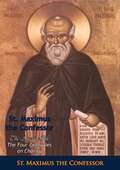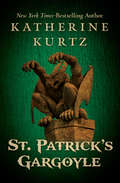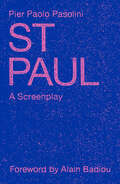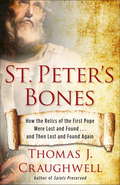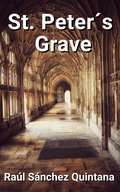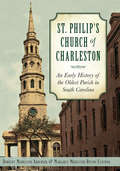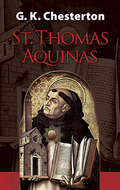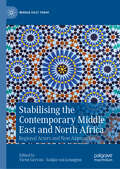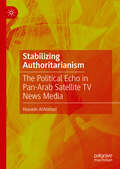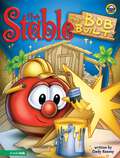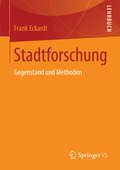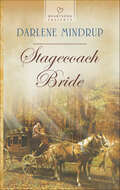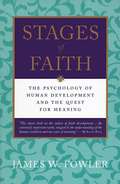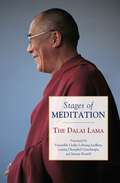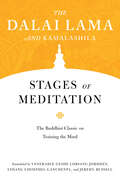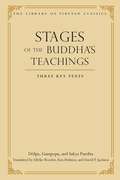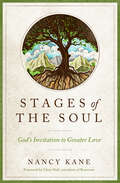- Table View
- List View
St. Maximus the Confessor: The Ascetic Life. The Four Centuries on Charity
by St. Maximus the ConfessorSt. Maximus the Confessor might well be called the Saint of Synthesis. His thought places him between the theologies of East and West and between the Middle Ages and the ancient Church. The Ascetic Life takes the form of question and answer between a novice and an old monk. The Four Centuries on Charity is written in the form of gnomic literature.-print ed.
St. Patrick's Gargoyle
by Katherine KurtzA gargoyle guardian and a Knight of Malta unite to seek justice when Dublin's St. Patrick's Cathedral is vandalized in this delightful modern-day fantasy. The gargoyles of Dublin, Ireland, have a sacred duty to perform. Formerly God's avenging angels, for centuries they have been entrusted with guarding the churches and cathedrals of the Irish capital while avoiding all contact with human beings. But once a month these loyal stone sentries must leave their posts to attend a conclave of their kind, and it is during one such absence that a sacrilege occurs. The guardian of St. Patrick's Cathedral, the gargoyle Padraig, called "Paddy," has returned to find violence and vandalism committed at his church and two silver artifacts stolen. Taking to Dublin's night streets in search of a culprit, Paddy inadvertently reveals himself to an aged chauffeur in an ancient Rolls Royce, thereby dooming Francis Templeton to an impending premature death. But the grim reaper will have to wait, because old man Templeton is a member of the Knights of Malta, a secret order of defenders of the faith dating back to the Crusades, and as such is an ideal partner for the onetime angel in his quest for justice and revenge. Their hunt is about to take some sinister turns, however, leading the gargoyle and the knight to Clontarf Castle, where a major demon, an emissary of Satan, is preparing to make his reentrance into the world. An acclaimed and much beloved fantasist best known for her popular Adept and Knights Templar series and her chronicles of the magical Deryni, Katherine Kurtz now displays another side of her extraordinary talent and succeeds magnificently. St. Patrick's Gargoyle is a delightful feast of the imagination, rich in Celtic lore and religious arcana, and brimming with wit and heart, wonder and magic.
St. Patrick: The First Missionary
by Thomas CahillA selection from How The Irish Saved Civilization, everything you need to know about the historical St. Patrick, the extraordinary Iron Age man who became Ireland's patron saint. The real St. Patrick neither dressed in green nor chased the snakes from Ireland; instead, he was a kind and courageous former slave who had been stolen from Britain during childhood and brought to Ireland. Though he escaped from slavery, he later returned in triumph to the island of his captivity. From the first volume of his widely acclaimed "Hinges of History" series, Thomas Cahill brings St. Patrick to life, and sheds light on the chaotic but starkly beautiful ancient Ireland. An eBook short.
St. Paul: A Screenplay
by Pier Paolo PasoliniPresented here for the first time in English is a remarkable screenplay about the apostle Paul by Pier Paolo Pasolini, legendary filmmaker, novelist, poet, and radical intellectual activist. Written between the appearance of his renowned film Teorema and the shocking, controversial Salò, or the 120 Days of Sodom, St Paul was deemed too risky for investors. At once a political intervention and cinematic breakthrough, the script forces a revolutionary transformation on the contemporary legacy of Paul. In Pasolini&’s kaleidoscope, we encounter fascistic movements, resistance fighters, and faltering revolutions, each of which reflects on aspects of the Pauline teachings. From Jerusalem to Wall Street and Greenwich Village, from the rise of SS troops to the death of Martin Luther King, Jr, here—as Alain Badiou writes in the foreword—&‘Paul&’s text crosses all these circumstances intact, as if it had foreseen them all&’. This is a key addition to the growing debate around St Paul and to the proliferation of literature centred on the current turn to religion in philosophy and critical theory, which embraces contemporary figures such as Alain Badiou, Slavoj i ek and Giorgio Agamben.
St. Paul: The Apostle We Love to Hate
by Karen ArmstrongSt. Paul is known throughout the world as the first Christian writer, authoring fourteen of the twenty-seven books in the New Testament. But as Karen Armstrong demonstrates, he also exerted a more significant influence on the spread of Christianity throughout the world than any other figure in history. It was Paul who established the first Christian churches in Europe and Asia in the first century, Paul who transformed a minor sect into the largest religion produced by Western civilization, and Paul who advanced the revolutionary idea that Christ could serve as a model for the possibility of transcendence. While we know little about some aspects of the life of St. Paul--his upbringing, the details of his death--his dramatic vision of God on the road to Damascus is one of the most powerful stories in the history of Christianity, and the life that followed forever changed the course of history. Some books, long-held to be written by Paul, were not written by him and some of his books were later edited to contain material not by him.
St. Peter's Bones: How the Relics of the First Pope Were Lost and Found . . . and Then Lost and Found Again
by Thomas J. CraughwellIn this fascinating account of the search for the remains of the world's first pope, none other than Peter, the chief apostle of Jesus, Thomas J. Craughwell takes us on one of the most exciting archaeological finds of the twentieth century. In 1448 a team of architects and engineers brought Pope Nicholas V unhappy news: the 1,100-year-old Basilica of St. Peter suffered from so many structural defects that it was beyond repair. The only solution was to pull down the old church--one of the most venerable churches in all of Christiandom--and erect a new basilica on the site. Incredibly, one of the tombs the builders paved over was the resting place of St. Peter. Then in 1939, while reconstructing the grottoes below St. Peter's Basilica, a workman's shovel struck not dirt or rock but open air. After inspecting what could be seen through the hole they'd made in the mausoleum's roof, Pope Pius XII secretly authorized a full-scale excavation. What lay beneath? The answer and the adventure await. In this riveting history, facts, traditions, and faith collide to reveal the investigation, betrayals, and mystery behind St. Peter's burial place.
St. Peter's Grave
by Raul Sanchez QuintanaIn 1953, during the times of exile destinated to construct the church of Dominus Flevit in the Olive Mount the Franciscans in Holy Land found an old cementary. Between the remains, they found a sarcophagus that was very important for the Christians, it grabbed their attention (real facts). The founding and content was communicated to Pio XII who quickly ordered to destruct part of the remains, however three frairs decided not to obey him and keep the discovery. Sixty years have passed and the three frairs die in different circumstances, the secret that jealousy they had kept. Since this instant, several interested people would try no know what was in that discovery found in the Olives Mount, with the objective of controling a weak Vatican, that had compromised relashionships from the high Curia and the Cosa Nostra. The novel that tried to reveal the motives that took Ratzinger to make the decision of abandoning the post of Saint Peter, this book develops in the times of Benedict XVI and the election of Pope Francis. But the novel starts to develop in the city of Granada, little by little it moves to the Vatican and the Island of Sicily.
St. Philip's Church of Charleston: An Early History of the Oldest Parish in South Carolina
by Margaret Middleton Eastman Dorothy Middleton AndersonSt. Philip's Church was commissioned shortly after the Carolina colony was founded in 1670. Because the Church of England was the established church, St. Philip's tried to meet the spiritual needs of the early settlers and also was responsible for oversight of elections, education and social services in everything from healthcare to disaster relief. St. Philip's churchwardens and vestry enforced morality laws and levied taxes. The colony's first state funeral--that of Governor Robert Johnson--took place in the church, as did that of the controversial, one-time vice president, Senator John C. Calhoun. Buried in the churchyard are Founding Fathers, pirate hunters, war heroes, statesmen and even the unfortunate victim of a sensational murder. This book recounts the early years of St. Philip's Church, the people who walked its aisles and some of the early religious conflicts that shook the community. Authors Dorothy Middleton Anderson and Margaret Middleton Rivers Eastman outline the fascinating history of the first church in the new colony.
St. Thomas Aquinas
by G. K. ChestertonAcclaimed as the best book ever written on St. Thomas, this outstanding profile introduces one of Christianity's most important and influential thinkers. G. K. Chesterton chronicles the saint's life, focusing on the man and the events that shaped him, rather than on theology. In a concise, witty, and eminently readable narrative, he illustrates the relevance of St. Thomas' achievements to modern readers. Born into an aristocratic family, Thomas rejected a life of privilege to join a new order of preaching and teaching monks, the Dominicans. Chesterton compares Thomas' views to those of another famous thirteenth-century figure, St. Francis of Assisi. He also explores the influence of Aristotelian philosophy on Thomas' character, along with the effects of Parisian culture, society, and politics. The final chapter examines the impact of Thomas' work on later religious thinkers, including Martin Luther. This brief but vivid profile provides fascinating glimpses into the medieval scholastic movement, and it presents an excellent beginning to further explorations of St. Thomas Aquinas' works.
St. Thomas Aquinas On Politics And Ethics (Norton Critical Editions)
by Thomas Aquinas Paul E. SigmundThe selections not only include St. Thomas Aquinas's views ongovernment, law, war, property, and sexual ethics, but also provide thetheological, epistemological, and psychological background for hispolitical and ethical thought, including the Five Proofs on theexistence of God and Aquinas's theories of knowledge, the soul, thepurpose of man, and the order of the universe. Throughout the book,footnotes explain technical terms and historical, biblical, andclassical references. "Backgrounds and Sources" follows the text, with selections from thewritings of Aristotle, St. Augustine, and Dionysius the Areopagite. "Interpretations" traces Aquinas's influence on medieval thought, onRoman Catholicism during the Renaissance, on early modern politicalthought (Richard Hooker and Francisco Suarez), on nineteenth-andtwentieth-century papal social thought, and on contemporary ChristianDemocratic political parties in Europe and Latin America. The volume concludes with "Contemporary Problems in Thomistic Ethics",which contains eight analyses of the influence of Aquinas's thought onmodern debates on war, contraception, and abortion. A Selected Bibliography is included.
Stabilising the Contemporary Middle East and North Africa: Regional Actors and New Approaches (Middle East Today)
by Saskia Van Genugten Victor GervaisThis book examines the changing dynamics of stabilisation efforts in the Middle East and North Africa. Written by recognised scholars and practitioners in the field, this volume provides a rich overview of the broader spectrum of stabilisation. The topics range from a comprehensive set of lessons learned in Afghanistan and Iraq to transitional justice and reconciliation efforts in Tunisia and international attempts to protect the region’s cultural heritage. Ultimately, this edited collection presents a comprehensive look at the attempts to increase stability in the MENA region.
Stabilizing Authoritarianism: The Political Echo in Pan-Arab Satellite TV News Media
by Hussein AlAhmadThe book explores the close relationship between media institutions and power elites in Arab societies. This relationship exists within an unprecedented state of competition among global powers for influence and control over necessary resources and consumer markets in the Middle East. These conflicts still ravage these societies, including Palestinian society, designated as a region characterized by "organized chaos," dominated by multiple forms of increasing political instability and complex sources of internal turmoil. Taking the specificity of the Palestinian internal conflict as a case study, the book explores the interrelationships between power elites at the three levels of international, regional, and domestic politics, via the news message of satellite TV news media outlets. This book will interest scholars of the Middle East, of media and authoritarianism, and of the sociology of the Arab world.
Stable that Bob Built / VeggieTales (Big Idea Books / VeggieTales)
by Cindy KenneyIn this silly story about a very Veggie Christmas Pageant, the beloved VeggieTales characters recreate the story of Jesus’ birth—complete with a mooing cow at the stable and pie-eating shepherds and their lambs.
Stadtforschung: Gegenstand und Methoden
by Frank EckardtDas Lehrbuch wendet sich an Studierende der Architektur, Stadtplanung, Urbanistik, Kunst und Kulturwissenschaften. Es soll den Studierenden ermöglichen, für ihr Studium und ihre Studienprojekte eine theoretische und methodische Grundlage zur Hand zu haben. Dabei soll einerseits ein Übersichtswissen vermittelt werden, in welcher Weise unterschiedliche Herangehensweisen aus den Sozialwissenschaften genutzt werden können, um konkrete Probleme in Städten in einer systematischen und realistischen Weise zu untersuchen. Andererseits wird das Buch zu grundlegenden Fragestellungen der Stadtforschung Positionen vermitteln, die zu einem besseren interdisziplinären Verständnis führen sollen.
Stagecoach Bride
by Darlene MindrupStagecoach Driver Adam Clark Is Used to Surprises But he never thought he'd find his childhood friend Amanda Ross applying for a dangerous driver's job. Now Adam's "little bundle of dynamite" is all grown up...and sparking feelings that are anything but brotherly. If he can't talk her out of her crazy scheme to assert her independence, he'll just have to protect her. Amanda's fiery personality dwarfs her small stature, but their journey westward tests even her indomitable spirit. And she learns she can trust Adam to keep her safe in the swirl of danger that surrounds them. Can these two old friends survive a treacherous trip...and open their hearts to one another before it's too late?
Stages of Faith: The Psychology of Human Development and the Quest For Meaning
by James W. FowlerFaith, as approached here, is not necessarily religious, nor is it to be equated with belief. Rather, faith is a person's way of leaning into and making sense of life. More verb that noun, faith is the dynamic system of images, values, and commitments that guide one's life. It is thus universal: everyone who chooses to go on living operated by some basic faith. Building on the contributions of such key thinkers as Piaget, Erikson, and Kohlberg, Fowler draws on a wide range of scholarship, literature, and firsthand research to present expertly and engagingly the six stages that emerge in working out the meaning of our lives--from the intuitive, imitative faith of childhood through conventional and then more independent faith to the universalizing, self-transcending faith of full maturity. Stages of Faith helps us to understand our own pilgrimage of faith, the passages of our own quest for meaning and value.
Stages of Meditation
by Kamalashila Dalai LamaA translation of the ancient classic Stages of Meditation, by Kamalashila, with commentary from everyone's favorite Buddhist teacher, the Dalai Lama.The Dalai Lama explains the principles of meditation in a practice-oriented format especially suited to Westerners. Based upon the middle section of the Bhavanakrama by Kamalashila--a translation of which is included--this is the most extensive commentary given by the Dalai Lama on this concise but important meditation handbook. It is a favorite text of the Dalai Lama, and he often takes the opportunity to give teachings on it to audiences throughout the world. In his words, "This text can be like a key that opens the door to all other major Buddhist scriptures." Topics include the nature of mind, how to develop compassion and loving-kindness, calm abiding wisdom, and how to establish a union of calm abiding and special insight.
Stages of Meditation: The Buddhist Classic on Training the Mind (Core Teachings of Dalai Lama #4)
by The Dalai Lama KamalashilaA translation of the ancient classic Stages of Meditation, by Kamalashila, with commentary from everyone's favorite Buddhist teacher, the Dalai Lama.The Dalai Lama explains the principles of meditation in a practice-oriented format especially suited to Westerners. Based upon the middle section of the Bhavanakrama by Kamalashila--a translation of which is included--this is the most extensive commentary given by the Dalai Lama on this concise but important meditation handbook. It is a favorite text of the Dalai Lama, and he often takes the opportunity to give teachings on it to audiences throughout the world. In his words, "This text can be like a key that opens the door to all other major Buddhist scriptures." Topics include the nature of mind, how to develop compassion and loving-kindness, calm abiding wisdom, and how to establish a union of calm abiding and special insight.
Stages of the Buddha's Teachings: Three Key Texts
by Dolpa Sakya Pandita Gampopa Ken Holmes David P. Jackson Ulrike RoeslerStages of the Buddha's Teachings is an extraordinary and systematized representation of the complete path to enlightenment. From the acclaimed Library of Tibetan Classics.The “stages of the teachings” or tenrim genre of Tibetan spiritual writing expounds the Mahayana teachings as a graded series of topics, from the practices required at the start of the bodhisattva’s career to the final perfect awakening of buddhahood. The three texts in the present volume all exerted seminal influence in the Tibetan Buddhist tradition. The first text, The Blue Compendium, presents the instructions of the Kadam teacher Potowa (1031–1106) as recorded by his student Dölpa (1059–1131). This text is followed by Gampopa’s (1079–1153) revered Ornament of Precious Liberation, which remains the most authoritative text on the path to enlightenment within the Kagyü school. The final text is Clarifying the Sage’s Intent, a masterwork by the preeiment sage of the Sakya tradition, Sakya Pandita (1182–1251).
Stages of the Path and the Oral Transmission: Selected Teachings of the Geluk School (Library of Tibetan Classics #6)
by Thupten JinpaA major contribution to the literature on Buddhist practice according to the Geluk school of Tibetan Buddhism from its foremost interpreter.Although it was the last major school to emerge in the Tibetan Buddhist tradition, the Geluk school has left an indelible mark on Buddhist thought and practice. The intellectual and spiritual brilliance of its founder, the great Tsongkhapa (1357–1419), has inspired generations of scholars and tantric yogis to place him at the heart of their daily meditative practice. The Geluk tradition&’s close ties to the Dalai Lamas have also afforded it an outsized influence in all aspects of Tibetan life for centuries. At its peak its combined monasteries boasted a population in the tens of thousands, and its sway encompassed the religious landscape of Mongolia and much of Central Asia. This widespread religious activity fostered a rich literary tradition, and fifteen seminal works are featured here representing four genres of that tradition. They include works on the stages of the path, or lamrim, the genre for which the Geluk is most renowned; works on guru yoga, centered around the core Geluk ritual Offering to the Guru (Lama Chöpa); teachings from the unique oral transmission of Geluk mahamudra, meditation on the nature of mind; and instructions on the three essential points—what to practice in life, at death, and in the bardo. Your guide to these riches, Thupten Jinpa, maps out their historical context and spiritual significance in his extensive introduction.
Stages of the Soul: God's Invitation to Greater Love
by Nancy KaneHow can you tell if you&’re actually growing?Sure, when you&’re working on getting rid of a huge character flaw you can see progress, but do you ever wish you had a roadmap for the spiritual journey for the rest of the time? Do you ever feel spiritually dry—or like something&’s just not working anymore in your spiritual life? If you find yourself longing for more satisfaction, joy, and intimacy with Christ, this book is for you. Stages of the Soul is about making tangible spiritual progress. It&’s about truly understanding—understanding like you&’ve never understood before—that you are deeply loved. Nancy Kane walks you through five stages of the soul&’s journey toward embracing God&’s love. As you learn about each stage you&’ll be able to:identify where you are in the process of spiritual growth understand the role of pain and suffering in your lifeexperience God&’s love in the radically deep way you were designed to experience it. Imagine loving God in a way that fills you up from the moment you wake up to the moment you go to bed. Imagine having Christ&’s love for the world flow out of your heart without insecurity, anxiety, or selfishness getting in the way. That what this bookis all about: radically deeper love. This book will help you see more clearly how the Lord tenderly guides us to greater wholeness, holiness, and love. But Stages of the Soul is not just another book, it will become both your companion and guide as you walk day by day in greater intimacy with ChristThere is nothing more valuable than help in your journey toward spiritual wholeness. Receive that gift today.
Stages of the Soul: God's Invitation to Greater Love
by Nancy KaneHow can you tell if you&’re actually growing?Sure, when you&’re working on getting rid of a huge character flaw you can see progress, but do you ever wish you had a roadmap for the spiritual journey for the rest of the time? Do you ever feel spiritually dry—or like something&’s just not working anymore in your spiritual life? If you find yourself longing for more satisfaction, joy, and intimacy with Christ, this book is for you. Stages of the Soul is about making tangible spiritual progress. It&’s about truly understanding—understanding like you&’ve never understood before—that you are deeply loved. Nancy Kane walks you through five stages of the soul&’s journey toward embracing God&’s love. As you learn about each stage you&’ll be able to:identify where you are in the process of spiritual growth understand the role of pain and suffering in your lifeexperience God&’s love in the radically deep way you were designed to experience it. Imagine loving God in a way that fills you up from the moment you wake up to the moment you go to bed. Imagine having Christ&’s love for the world flow out of your heart without insecurity, anxiety, or selfishness getting in the way. That what this bookis all about: radically deeper love. This book will help you see more clearly how the Lord tenderly guides us to greater wholeness, holiness, and love. But Stages of the Soul is not just another book, it will become both your companion and guide as you walk day by day in greater intimacy with ChristThere is nothing more valuable than help in your journey toward spiritual wholeness. Receive that gift today.
Staging Contemplation: Participatory Theology in Middle English Prose, Verse, and Drama
by Eleanor JohnsonWhat does it mean to contemplate? In the Middle Ages, more than merely thinking with intensity, it was a religious practice entailing utter receptiveness to the divine presence. Contemplation is widely considered by scholars today to have been the highest form of devotional prayer, a rarified means of experiencing God practiced only by the most devout of monks, nuns, and mystics. Yet, in this groundbreaking new book, Eleanor Johnson argues instead for the pervasiveness and accessibility of contemplative works to medieval audiences. By drawing together ostensibly diverse literary genres—devotional prose, allegorical poetry, cycle dramas, and morality plays—Staging Contemplation paints late Middle English contemplative writing as a broad genre that operated collectively and experientially as much as through radical individual disengagement from the world. Johnson further argues that the contemplative genre played a crucial role in the exploration of the English vernacular as a literary and theological language in the fifteenth century, tracing how these works engaged modes of disfluency—from strained syntax and aberrant grammar, to puns, slang, code-switching, and laughter—to explore the limits, norms, and potential of English as a devotional language. Full of virtuoso close readings, this book demonstrates a sustained interest in how poetic language can foster a participatory experience of likeness to God among lay and devotional audiences alike.
Staging Faith: Religion and African American Theater from the Harlem Renaissance to World War II
by Craig R. PrentissIn the years between the Harlem Renaissance and World War II, African American playwrights gave birth to a vital black theater movement in the U.S. It was a movement overwhelmingly concerned with the role of religion in black identity. In a time of profound social transformation fueled by a massive migration from the rural south to the urban‑industrial centers of the north, scripts penned by dozens of black playwrights reflected cultural tensions, often rooted in class, that revealed competing conceptions of religion's role in the formation of racial identity.Black playwrights pointed in quite different ways toward approaches to church, scripture, belief, and ritual that they deemed beneficial to the advancement of the race. Their plays were important not only in mirroring theological reflection of the time, but in helping to shape African American thought about religion in black communities. The religious themes of these plays were in effect arguments about the place of religion in African American lives.In Staging Faith, Craig R. Prentiss illuminates the creative strategies playwrights used to grapple with religion. With a lively and engaging style, the volume brings long forgotten plays to life as it chronicles the cultural and religious fissures that marked early twentieth century African American society.Craig R. Prentiss is Professor of Religious Studies at Rockhurst University in Kansas City, Missouri. He is the editor of Religion and the Creation of Race and Ethnicity: An Introduction (New York University Press, 2003).
Staging Muslims in Britain: Playwriting, Performance, and Representation (Routledge Advances in Theatre & Performance Studies)
by Önder ÇakırtaşThis scholarly volume delves into the manner in which British Muslims articulate their cultural, social and religious identities through theatrical productions in 21st-century Britain and examines their portrayal within these performances.The study investigates the factors influencing the emergence and evolution of Islamic theatre in Britain, providing an in-depth analysis of plays by British playwrights of both Muslim and non-Muslim origins that have shaped the trajectory of British Islamic theatre from the late 20th century to the present. Önder Çakırtaş critically examines how British playwrights, predominantly of Muslim origin but also including some of non-Muslim origin, depict Muslim identity and culture from their unique perspectives, particularly in the context of post-9/11 society. Adopting a comprehensive approach to Islamic playwriting and performance, this book highlights the accomplishments and contributions of contemporary British playwrights, primarily from Muslim backgrounds.This study will be of significant interest to scholars and students in theatre studies, as well as related disciplines such as Islamic studies, sociology and political science.
